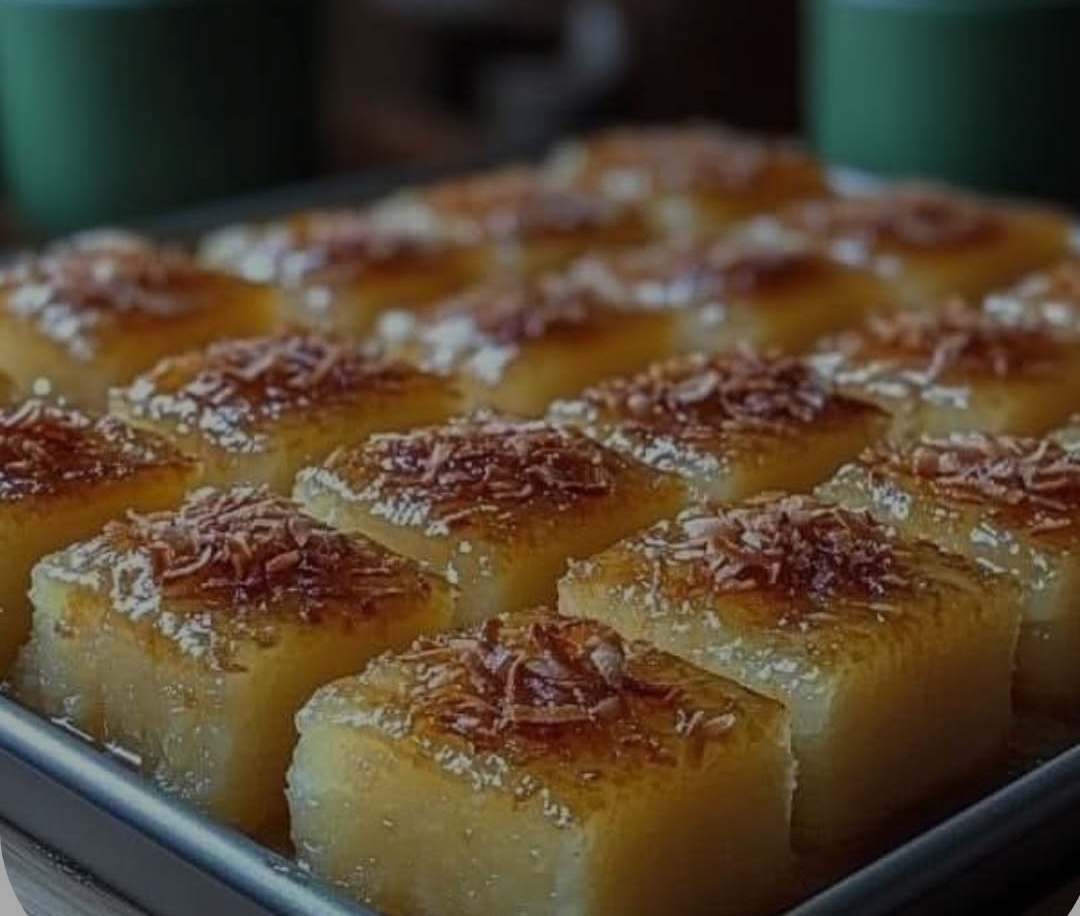Sure! Here’s a comprehensive and beautifully detailed write-up for Cassava Cake with Macapuno—covering its history, ingredients, instructions, nutritional benefits, and more.
Cassava Cake with Macapuno: A Beloved Filipino Classic
Introduction
Cassava Cake with Macapuno is a cherished dessert in Filipino cuisine, made primarily from grated cassava (also called yuca or manioc) and enriched with coconut flavors. It’s a moist, chewy, and sweet treat often served during special gatherings, holidays, fiestas, and family occasions. Macapuno, a soft and jelly-like variety of coconut, gives the cake its uniquely creamy and indulgent topping. This beloved dessert brings back nostalgic memories for many Filipinos, with recipes passed down from generations.
A Bit of History
Cassava was introduced to the Philippines during the Spanish colonization era, having originated from South America. Over time, the Filipino people incorporated cassava into many dishes—both savory and sweet. The combination of cassava and coconut was a natural progression, given the tropical abundance of coconuts in the Philippines. Cassava Cake with Macapuno is a staple dessert that showcases the resourcefulness and creativity of Filipino home cooks.
Ingredients
Base:
- 2 cups grated cassava (fresh or frozen, thawed if frozen)
- 1 cup coconut milk
- 1 cup evaporated milk
- 1 cup sweetened condensed milk
- 3/4 cup sugar
- 1/4 cup melted butter
- 2 eggs
Topping:
- 1 cup macapuno (use bottled macapuno strings)
- 1/2 cup coconut milk
- 1/4 cup condensed milk
- 1 tablespoon cornstarch (dissolved in 2 tablespoons water)
- Pinch of salt
Instructions & Method
Step 1: Prepare the Cassava Mixture
- Preheat oven to 350°F (175°C). Grease a 9×9-inch or similar-sized baking pan.
- In a large bowl, combine grated cassava, coconut milk, evaporated milk, condensed milk, sugar, melted butter, and eggs.
- Mix until smooth and well-blended.
- Pour the mixture into the prepared pan and spread evenly.
Step 2: Bake the Base
- Bake in the preheated oven for 45–50 minutes, or until the top is set and slightly golden.
- While baking, prepare the topping.
Step 3: Make the Topping
- In a saucepan over low heat, combine macapuno, coconut milk, condensed milk, and a pinch of salt.
- Add the cornstarch slurry and stir continuously until thickened (about 3–5 minutes).
- Remove from heat and let it cool slightly.
Step 4: Assemble and Finish
- Once the base is set, remove it from the oven and gently spread the macapuno topping over it.
- Return to the oven and bake for an additional 15–20 minutes, or until the topping is set and lightly golden.
- Let the cake cool completely before slicing into squares.
Formation & Presentation
Once cooled, the cassava cake should be firm yet tender, with a shiny, luscious macapuno topping. You can slice it into diamond or square shapes and serve it at room temperature. It’s best enjoyed with coffee or salabat (ginger tea).
Nutritional Benefits
- Cassava is rich in carbohydrates, particularly starch, making it a good energy source.
- Coconut milk provides healthy fats and a creamy flavor.
- Macapuno adds fiber and natural sweetness.
- Eggs and milk add protein and essential nutrients.
Note: Due to its richness and sugar content, cassava cake is best enjoyed in moderation, especially for those watching blood sugar levels.
Why People Love Cassava Cake
- Nostalgia – It reminds many of childhood and Filipino celebrations.
- Texture – The soft, chewy texture is deeply satisfying.
- Flavor – The richness of coconut milk and macapuno balances sweetness and creaminess.
- Versatility – It’s enjoyed warm, chilled, or at room temp.
- Community – Often made for sharing, it brings people together.
Conclusion
Cassava Cake with Macapuno is more than just a dessert—it’s a celebration of Filipino heritage, flavors, and warmth. Whether you’re new to Filipino cuisine or continuing a family tradition, this cake is a delicious way to share love and culture on a plate.
Would you like a printable version of this or a visual layout for sharing online?
